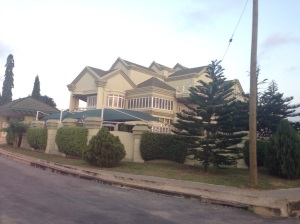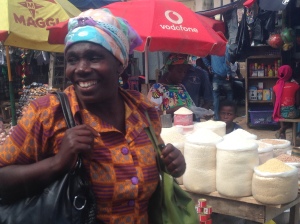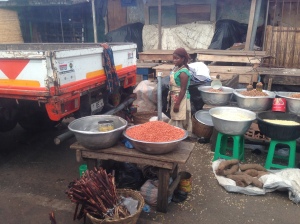Today I got my first glimpse at some of the harsh realities that exist in Ghana. My  neighborhood, East Legon, is one of the most affluent parts of Accra. When exploring the neighborhood, it is not uncommon to see houses larger than my own, or Ghanaians driving Range Rovers. Keep in mind that cars here can cost 2-3 times more than in America. For the first two days of the trip, this neighborhood of affluence has been my only image of Accra.
neighborhood, East Legon, is one of the most affluent parts of Accra. When exploring the neighborhood, it is not uncommon to see houses larger than my own, or Ghanaians driving Range Rovers. Keep in mind that cars here can cost 2-3 times more than in America. For the first two days of the trip, this neighborhood of affluence has been my only image of Accra.
Today was my first time being exposed to how the typical Ghanaian lives. The average income in the country is a mere 400 US dollars per year. As our bus left East Legon and traveled into the more impoverished areas of the city, this reality sank in.
Locals lined the sidewalks, selling goods in the street, as this is how many poor Ghanaians earn their living. Unlike East Legon, the houses in this community don’t have running water. Cooking, bathing, and most other activities are done outside the home. When the day is over, the people return inside, where they usually sleep on a mat on the floor.
Waste, particularly e-waste, is also a huge issue in the city. Between the fruit and vegetable stands, there are large piles of trash that there are no other place for, as  well as old computers that Ghanaians burn in order to extract precious metals.
well as old computers that Ghanaians burn in order to extract precious metals.
I looked outside the bus window, trying my best to take in everything that I was seeing. I took photos with my iPhone, sickened by the fact that most of the people whose picture I was taking would have to work for over two years to afford it. I thought about the things that are ‘normal’ to me in America, the things I take for granted. The fireplace in my room, for example, or the pool in my backyard. My world is not the real world. Today, that real world, the world that the majority of people live in, hit me right in the face.
After about 10 minutes of analyzing the negative aspects of these people’s lives and feeling sorry for them, I snapped a photo of a woman turning to talk to her friend in the street. Something about her smile intrigued me. In every image I have seen of African poverty, the people were sad. I was confused at how  someone in her economic position could possibly be happy. I put my camera down and watched her interact, and soon a group of seven locals had left the sidewalk to join the conversation. They talked and laughed, and when they were finished they helped one of the women haul more fruit over to her stand before getting back to their work.
someone in her economic position could possibly be happy. I put my camera down and watched her interact, and soon a group of seven locals had left the sidewalk to join the conversation. They talked and laughed, and when they were finished they helped one of the women haul more fruit over to her stand before getting back to their work.
As the bus drove down the road, I found myself envying certain aspects of the lives of these people, the same people I had pitied just minutes before. The sense of community in the area was overwhelming, and is something that is often missing in the place that I call home. Everywhere I looked people were talking, interacting, and helping each other. Down past the fruit stands, over 50 locals, some strangers, laughed while they watched and participated in a game of pick-up soccer.
While life in America is centered around consumption, life in Ghana is centered around relationships. I’ve noticed that even complete strangers treat each other like family here. This sense of community and belonging makes Ghanaians some of the happiest people I’ve ever seen, even though many are living in dire poverty.
Being privileged, it is easy to come into these communities and focus on the the suffering. But after opening my eyes and my mind, I discovered value in this very poor neighborhood, and learned an important lesson. I thought about how I place so much value on commodities, yet take so many relationships for granted. I thought about how I often let the things I have, rather than the people I love, define my happiness. How do you determine your happiness? Food for thought.
